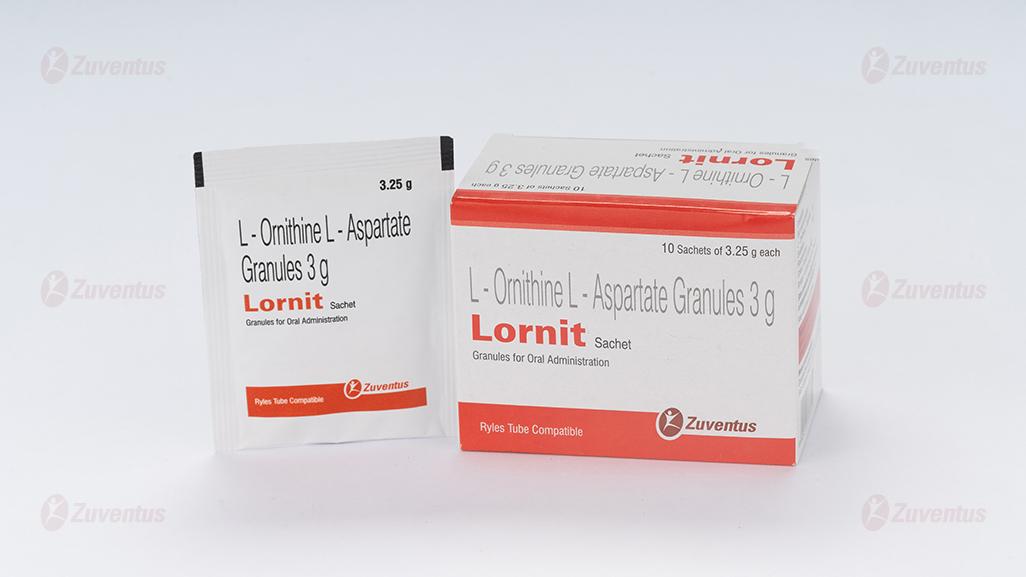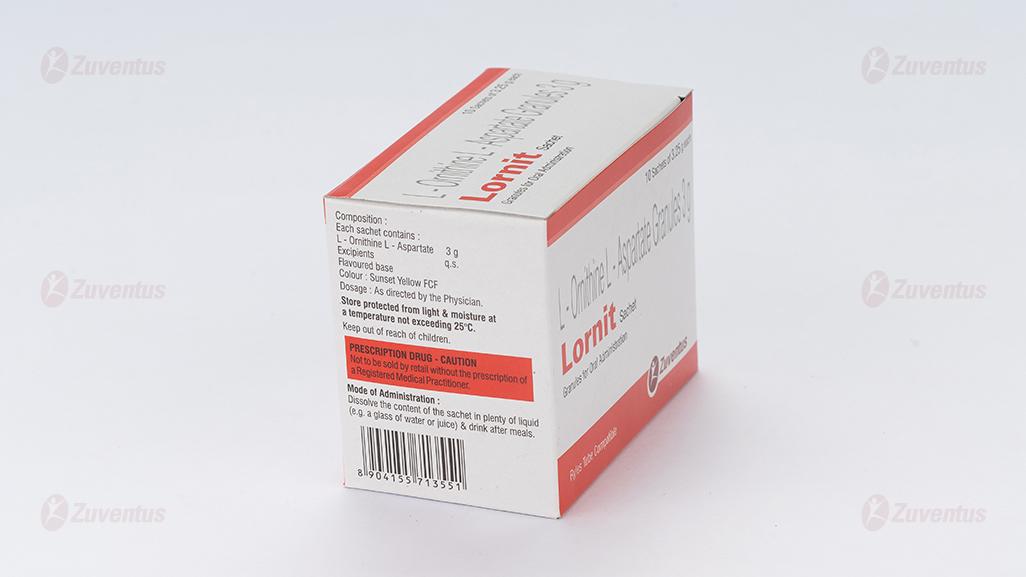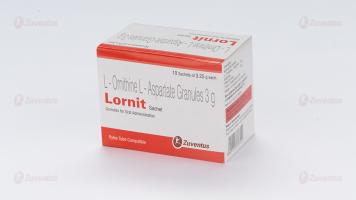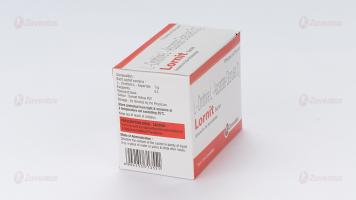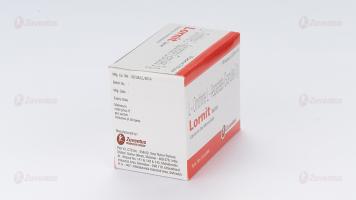Lornit Sachet
Therapy Area
Gastrointestinal
1.0 Generic name
L - Ornithine L - Aspartate Granules 3 g
Granules for oral solution
2.0 Qualitative and quantitative composition
Composition:
Each sachet contains:
L - Ornithine L - Aspartate 3 g
Flavoured base
Colour: Sunset Yellow FCF
3.0 Dosage form and strength
Dosage form - Granules for oral solution.
Dosage Strength – 3g
4.0 Clinical particulars
4.1 Therapeutic Indications
Treatment of concomitant disease and sequelae due to impaired hepatic detoxification activity (e.g. in cirrhosis of the liver) with the symptoms of latent and manifest hepatic encephalopathy.
4.2 Posology and method of administration
The dissolved contents of 1-2 sachets of Lornit granules are taken up to 3 times daily. Lornit granules are dissolved in plenty of fluid (e.g. a glass of water, tea or juice) and taken after meals. The experiences on the use of the drug in children are limited. Lornit sachet can also be administered through Ryle tube.
4.3 Contraindications
Hypersensitivity to L-Ornithine-L-Aspartate, or any of the excipients.
Severely impaired renal function (renal insufficiency). A serum creatinine value over 3 mg / 100 ml can be used as a guideline value.
4.4 Special warnings and special precautions for use
Lornit granules may be harmful to the teeth (caries) in long-term use. No data are so far available on the use of the drug in children.
4.5 Drug Interactions
No interaction studies have been performed. Up to now interactions are not known.
4.6 Use in Special population
Pregnancy and lactation
No clinical data are available relating to intake of Lornit granules during pregnancy. No exhaustive animal studies have been performed for L-Ornithine-L-Aspartate, to investigate its toxicity in relation to reproduction. Administration of Lornit granules during pregnancy should therefore be avoided. If, however, treatment with Lornit granules is considered necessary, careful consideration should be given to the benefit versus risk ratio.
It is not known whether L-Ornithine-L-Aspartate is excreted into the breast milk. Administration of Lornit granules should therefore be avoided during lactation. If, however, treatment with Lornit granules is considered necessary, careful consideration should be given to the benefit versus risk ratio.
4.7 Effects on ability to drive and use machines
As a result of the disease, the ability to drive and use machines may be impaired during treatment with L-Ornithine-L-Aspartate.
4.8 Undesirable effects
Very common: (>1/10)
Common: (>1/100, <1/10)
Uncommon: (>1/1000, <1/100)
Rare: (>1/10000, <1/1000)
Very rare: (<1/10000), not known (cannot be estimated)
Gastrointestinal disorders
Uncommon: Nausea, vomiting, stomach ache, flatulence, diarrhoea.
Musculoskeletal and connective tissue disorders
Very rare: pain in the limbs
These undesirable effects are usually transient and do not require withdrawal of the medicine.
Reporting suspected adverse reactions after authorisation of the medicinal product is important. It allows continued monitoring of the benefit/risk balance of the medicinal product. Healthcare professionals are asked to report any suspected adverse reactions via email to: www.medico@zuventus.com
Website: https://www.zuventus.com/drug-safety-reporting
By reporting side effects, you can help provide more information on the safety of this medicine.
4.9 Overdose
So far signs of intoxication have not been observed following an overdose of L-ornithine L-aspartate. Symptomatic treatment is recommended if overdose occurs.
5.0 Pharmacological properties
5.1 Pharmacodynamic properties/Mechanism of action
Pharmacotherapeutic group: Liver therapy, ATC code: A05BA
In vivo, L-Ornithine-L-Aspartate exerts its effects through the amino acids, ornithine and aspartate, via two key methods of ammonia detoxification: urea synthesis and glutamine synthesis.
Urea synthesis takes place in the periportal hepatocytes. In these cells, ornithine serves both as an activator of the enzymes ornithine-carbamoyltransferase and carbamoyl phosphate synthetase and also as the substrate of urea synthesis.
Glutamine synthesis is localised in the perivenous hepatocytes. Particularly under pathological conditions, aspartate and other dicarboxylates, including the metabolic products of ornithine, are absorbed into the cells and used there to bind ammonia in the form of glutamine.
Glutamate is an amino acid that binds ammonia under both physiological and pathophysiological conditions. The resulting amino acid glutamine not only represents a non-toxic form for the excretion of ammonia, but also activates the important urea cycle (intercellular glutamine exchange).
Under physiological conditions, ornithine and aspartate are not limiting for urea synthesis.
Animal studies suggest that the ammonia-reducing effect of L-Ornithine-L-Aspartate is caused by enhanced glutamine synthesis. Individual clinical studies have shown an improved branched-chain amino acid/aromatic amino acid quotient.
5.2 Pharmacokinetic properties
L-Ornithine-L-Aspartate is rapidly absorbed and cleaved to form ornithine and aspartate.
Both amino acids have a short elimination half-life of 0.3 – 0.4 hours.
A fraction of the aspartate is recovered in unmetabolised form in the urine.
6.0 Nonclinical properties
6.1 Preclinical safety data
Based on pharmacological safety studies, preclinical data show that with correct use there is no particular risk of toxicity following repeated administration or mutagenicity in humans. No studies on carcinogenic potential have been carried out. In a dose discovery study, L-ornithine L-aspartate was investigated for reproduction toxicity only to a limited extent.
7.0 Description
L-Ornithine-L-Aspartate is a stable salt of the amino acids ornithine and aspartic acid. Reduces blood ammonia concentrations and improves mental function when administered in patients with hepatic encephalopathy.
Molecular Formula: C9H19N3O6
Molecular Weight: 265.26 g/mol

8.0 Pharmaceutical particulars
8.1 Incompatibilities
Not applicable.
8.2 Shelf life
Refer on pack
8.3 Packaging information
10 Sachets of 3.25 g each The granules are Sunset Yellow FCF in colour.
8.4 Special precautions for storage
Store protected from light & moisture at a temperature not exceeding 25°C.
9.0 Patient counselling information
- You will be regularly monitored for blood creatinine and blood/urine urea levels.
- Inform your doctor if you are pregnant, planning a pregnancy, or breastfeeding.
- Do not take Lornit Granules if you are allergic to any of its ingredients.
- It is not known whether it is safe to consume alcohol with Lornit Granules.
About leaflet
Read all of this leaflet carefully before you start using this medicine, because it contains important information for you.
Always take this exactly as described in this leaflet or as your doctor or pharmacist has told to you.
- Keep this leaflet. You may need to read it again.
- Ask your doctor or pharmacist if you need more information or advice.
- If you get any side effects, talk to your doctor or pharmacist. This includes side effects, not listed in this leaflet. See section 4.
- You must talk to a doctor if you do not feel better or if you feel worse.
In this leaflet:
- What Lornit sachet are and what they are used for
- What you need to know before you take Lornit sachet
- How to take Lornit sachet
- Possible side effects
- How to store Lornit sachet
- Contents of the pack and other information
1. What Lornit Sachet Are and What They Are Used for
Lornit sachet are a medicine which stimulates ammonia detoxification by increasing urea synthesis in the liver. Furthermore, it serves ammonia detoxification in the tissues outside the liver.
Lornit sachet are used in the treatment of co-existing and subsequent disorders resulting from impaired detoxification activity in the liver (e.g. in cirrhosis of the liver) with symptoms of latent and manifest hepatic encephalopathy.
2. What You Need to Know Before You Take Lornit Sachet
Do not take Lornit sachet
- if you react hypersensitively (allergically) to L-Ornithine-L-Aspartate, or any of the other ingredients of Lornit sachet -if you suffer from severely impaired kidney function (renal insufficiency). A serum creatinine value over 3 mg / 100 ml can be used as a guideline value
Warnings and precautions
Talk to your doctor or pharmacist before taking Lornit sachet.
Children
No data are so far available on the use of this medicine in children.
Other medicines and Lornit sachet
Please tell your doctor or pharmacist if you are taking/using or have recently taken/used any other medicines, including medicines obtained without a prescription. No interactions are known so far.
Pregnancy and breast-feeding:
Safety of use of Lornit sachet has not been established during pregnancy. If you are pregnant, you should therefore only take Lornit sachet if directed by your doctor. It is not known whether the active substance contained in Lornit sachet crosses into the breast milk. If you are breast-feeding, you should therefore only take Lornit sachet if directed by your doctor.
Ask your doctor or pharmacist for advice before taking any medicine.
Driving and using machines:
As a result of your illness, your ability to drive and use machines may be impaired during treatment with Lornit Sachet.
3. How to Take Lornit granules
Always take Lornit sachet exactly as your doctor has told you. You should check with your doctor or pharmacist if you are not sure.
Unless otherwise prescribed by your doctor, the usual dose is as follows: Take the dissolved contents of 1 - 2 sachets of Lornit sachet, up to 3 times daily.
Mode of administration:
Lornit sachet should be dissolved in plenty of fluid (e.g. a glass of water, tea or juice) and taken with or after meals.
The ready to use solution should be used immediately following preparation.
Lornit sachet can also be administered through Ryle tube.
If you take more Lornit Sachet than you should:
So far no signs of intoxication have been observed following an overdose of L-Ornithine-L-Aspartate. If necessary, your doctor will treat the symptoms.
If you forget to take Lornit Sachet:
Do not take a double dose to make up for a forgotten dose. Just take the next dose at the correct time, as described in the dosage instructions. If you have any further questions on the use of this product, ask your doctor or pharmacist.
4. Possible Side Effects
Like all medicines, Lornit Sachet can cause side effects, although not everybody gets them.
Possible side effects of Lornit Sachet:
Gastrointestinal disorders
Uncommon: Nausea, vomiting, stomach ache, flatulence, diarrhoea Musculoskeletal and connective tissue disorders
Very rare: Pain in the limbs
These side effects are usually transient and do not require withdrawal of the medicine.
Side effects are classified according to the following frequency data:
| Very common | may affect more than 1 of 10 people |
| Common | may affect up to 1 of 10 people |
| Uncommon | may affect up to 1 of 100 people |
| Rare | may affect up to 1 of 1,000 people |
| Very rare | may affect up to 1 of 10,000 people |
| Not known | frequency cannot be estimated from the available data |
Reporting of side effects
If you get any side effects, talk to your doctor. This includes any possible side effects not listed in this leaflet. You can also report side effects directly: Website: www.zuventus.com and click the tab “Drug Safety Reporting” located on the top of the home page. By reporting side effects, you can help provide more information on the safety of this medicine.
5. How to Store Lornit Sachet
Keep out of the reach and sight of children.
Do not use Lornit sachet after the expiry date which is stated on the outer carton/container.
Do not store above 25°C.
6. Content of the Pack and Other Information
What Lornit Sachet contain:
The active substance is L-ornithine-L-aspartate.
1 sachet with 3.25 g g granules for oral solution contains 3 g L-ornithine-L-aspartate. The granules are Sunset Yellow FCF in colour. 10 Sachets of 3.25 g each

